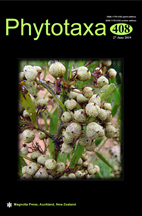Abstract
Cololejeunea (Spruce 1884: 291) Stephani (1891: 208), with over 400 published binominals, is the largest genus of Lejeuneaceae Cavers (1910: 291) and the most species of the genus are distributed in the tropical and subtropical regions (Zhu & So 2001, Yu et al. 2013). These usually small sized liverworts grow preferably in extreme habitats, such as on the surface of living leaves, on twigs, or in running water (Gradstein et al. 2003). The currently accepted generic concept of the genus is based on its incubous foliation, leaves consisting of a dorsal lobe and a ventral lobule, Lejeunea-type branching, lack of underleaves, and transverse section of stem comprising of 5(–8) cortical cells and 1 medullary cell (Yu et al. 2013, and references therein).

